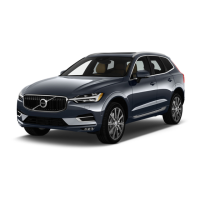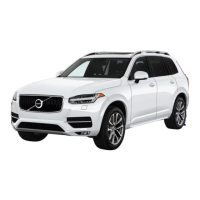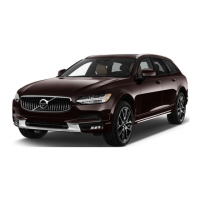Do you have a question about the Volvo XC40 2018 and is the answer not in the manual?
Personal ID for accessing online services like Volvo On Call, map services, and booking service.
The car's intelligent interface for entertainment, navigation, and information services.
Assistance system with an app to remotely control car functions like locking, fuel level, and preconditioning.
Allows saving and adapting car settings to individual driver preferences, linked to car keys.
How to check and calibrate tyre pressure using the Car status app and ITPMS.
Procedure to check engine oil level via the Car status app and book service.
Automatic adjustment of door mirrors when reversing and for locking/unlocking the car.
How to lock and unlock the car using the remote control key without physical contact.
Operation of the opening glass cover and sun blind for the panoramic roof.
Operation of the power tailgate, including foot-operated function and maximum opening programming.
Details on using the remote control key for locking, unlocking, and activating the panic function.
Function to lock the tailgate specifically, useful for service or hotel stays.
Controls main car functions like media, navigation, climate, and driver support systems.
Shows driving-related information such as speed, navigation, and active driver support.
How to start and stop the car's engine using the start/stop button.
Selection and customization of driving characteristics like Comfort, Eco, Dynamic, and Individual.
Operation of the parking brake, including automatic braking when stationary.
How to use the wireless charging plate for compatible smartphones.
Using the hook in the glovebox to hang bags or support items.
Location and function of the switch to activate/deactivate the passenger airbag.
Navigating between home, function, and app views, and accessing the top view.
Changing themes and backgrounds for the centre and driver displays.
How to lock the touch function for safe cleaning of the centre display.
Information shown in the status bar and climate controls at the bottom of the display.
Using the seat-shaped and four-way controls for seat position and lumbar support.
How to save and recall preferred seat and mirror positions using memory buttons.
Procedure for electronically folding the rear seat backrests and head restraints.
Steps for manually raising the rear seat backrests and head restraints.
How to adjust the steering wheel for height and depth.
Using the left-hand keypad for driver support functions like Cruise Control and Pilot Assist.
Navigating menus and controlling media/phone via the right-hand keypad.
Activating voice control using the steering wheel button for various car functions.
Viewing driving data like mileage, fuel consumption, and average speed.
Operation of headlamps, including AUTO mode, main beam, and dimming.
How active bending lights enhance visibility in bends by following steering movements.
Activation of exterior lighting for approaching and leaving the car in the dark.
Procedure for resetting the manual trip meter (TM) and automatic trip meter (TA).
Operation of windscreen wipers and washers, including rain sensor sensitivity.
How to operate the rear window wiper for intermittent and continuous wiping.
Engaging service position for wipers for cleaning or replacement.
Heating or cooling the cabin before driving using the centre display or Volvo On Call app.
Adjusting temperature, seat heating, and fan speed for front and rear climate zones.
Automatic air cleaning system that removes contaminants from the cabin air.
Connecting the car to the internet using a personal SIM card via the built-in modem.
Sharing the car's internet connection as a Wi-Fi hotspot with other devices.
Pairing phones for calls, SMS, and potentially internet connection via Bluetooth.
Making and receiving calls via Bluetooth-connected phone through the car system.
Audio playback from external devices via Bluetooth or USB connection.
Using smartphone apps like music and podcasts via the car's centre display.
Accessing map navigation and setting destinations using Sensus Navigation.
Accessing and controlling music from external devices or radio stations.
Accessing phone functions like call history, contacts, and manual dialing.
Quickly accessing the most recently used car function or app.
Activating/deactivating various driver assistance systems like Lane Keeping Aid and Park Assist.
Using camera views and parking assistance features like Park In and Park Out.
Accessing functions like Headrest fold and Road Sign Information.
Activating/deactivating car functions like Lane Keeping Aid and Park Assist.
Accessing installed car apps and managing downloads, updates, and uninstalls.
Customizing the layout of apps and function buttons by moving icons.
Setting personal preferences for displays, seats, audio, navigation, language, and voice control.
Creating, selecting, and connecting driver profiles to car keys for personalized settings.
Adapting drive modes like Comfort, Eco, or Dynamic to individual driving characteristics.
Adjusting or muting system sounds, such as screen tap feedback.
System to prevent or mitigate collisions with vehicles, pedestrians, or animals.
Alerts about vehicles in the blind spot and approaching vehicles in adjacent lanes.
Warns of crossing traffic when reversing and can apply auto-brake.
Assists in preventing the car from unintentionally leaving its lane.
Actively steers the car back into its lane or swerves to avoid collision.
Comfort function for lane keeping and maintaining distance to the vehicle ahead.
Checks parking space size and steers the car into it, requiring driver supervision.
Steps for using Park Assist Pilot to park the car parallel or perpendicularly.
Using Park Assist Pilot to maneuver the car out of a parallel parking space.
Assists in observing obstacles using camera images and park assist lines.
Advice on planning journeys to reduce fuel consumption and emissions.
Tips for driving economically, including Eco drive mode, idling, and speed.
Factors like traffic, road conditions, and weather that influence fuel consumption.
Voice commands for controlling radio, media playback, and audio sources.
Voice commands for making calls and managing phone contacts.
Voice commands for adjusting temperature, fan speed, and air distribution.
Voice commands for setting destinations, finding points of interest, and managing navigation.
Special notes regarding the remote control key when leaving the car.
Important advice on using the parking brake, especially on slopes.
Precautions for using the wireless phone charger to avoid overheating.
Safety advice on adjusting the driver's seat before driving.
Ensuring rear backrests and head restraints are locked after folding/raising.
Warnings regarding heated seats and preconditioning in certain environments.
Driver support systems are aids and do not replace driver responsibility.
Park Assist is a supplementary aid; driver bears full responsibility for parking safety.
Instructions for cleaning the centre display safely without damage.
Notes on wiper service position and avoiding paint damage.
Information on electrical socket power limits and data traffic costs.
Personal ID for accessing online services like Volvo On Call, map services, and booking service.
The car's intelligent interface for entertainment, navigation, and information services.
Assistance system with an app to remotely control car functions like locking, fuel level, and preconditioning.
Allows saving and adapting car settings to individual driver preferences, linked to car keys.
How to check and calibrate tyre pressure using the Car status app and ITPMS.
Procedure to check engine oil level via the Car status app and book service.
Automatic adjustment of door mirrors when reversing and for locking/unlocking the car.
How to lock and unlock the car using the remote control key without physical contact.
Operation of the opening glass cover and sun blind for the panoramic roof.
Operation of the power tailgate, including foot-operated function and maximum opening programming.
Details on using the remote control key for locking, unlocking, and activating the panic function.
Function to lock the tailgate specifically, useful for service or hotel stays.
Controls main car functions like media, navigation, climate, and driver support systems.
Shows driving-related information such as speed, navigation, and active driver support.
How to start and stop the car's engine using the start/stop button.
Selection and customization of driving characteristics like Comfort, Eco, Dynamic, and Individual.
Operation of the parking brake, including automatic braking when stationary.
How to use the wireless charging plate for compatible smartphones.
Using the hook in the glovebox to hang bags or support items.
Location and function of the switch to activate/deactivate the passenger airbag.
Navigating between home, function, and app views, and accessing the top view.
Changing themes and backgrounds for the centre and driver displays.
How to lock the touch function for safe cleaning of the centre display.
Information shown in the status bar and climate controls at the bottom of the display.
Using the seat-shaped and four-way controls for seat position and lumbar support.
How to save and recall preferred seat and mirror positions using memory buttons.
Procedure for electronically folding the rear seat backrests and head restraints.
Steps for manually raising the rear seat backrests and head restraints.
How to adjust the steering wheel for height and depth.
Using the left-hand keypad for driver support functions like Cruise Control and Pilot Assist.
Navigating menus and controlling media/phone via the right-hand keypad.
Activating voice control using the steering wheel button for various car functions.
Viewing driving data like mileage, fuel consumption, and average speed.
Operation of headlamps, including AUTO mode, main beam, and dimming.
How active bending lights enhance visibility in bends by following steering movements.
Activation of exterior lighting for approaching and leaving the car in the dark.
Procedure for resetting the manual trip meter (TM) and automatic trip meter (TA).
Operation of windscreen wipers and washers, including rain sensor sensitivity.
How to operate the rear window wiper for intermittent and continuous wiping.
Engaging service position for wipers for cleaning or replacement.
Heating or cooling the cabin before driving using the centre display or Volvo On Call app.
Adjusting temperature, seat heating, and fan speed for front and rear climate zones.
Automatic air cleaning system that removes contaminants from the cabin air.
Connecting the car to the internet using a personal SIM card via the built-in modem.
Sharing the car's internet connection as a Wi-Fi hotspot with other devices.
Pairing phones for calls, SMS, and potentially internet connection via Bluetooth.
Making and receiving calls via Bluetooth-connected phone through the car system.
Audio playback from external devices via Bluetooth or USB connection.
Using smartphone apps like music and podcasts via the car's centre display.
Accessing map navigation and setting destinations using Sensus Navigation.
Accessing and controlling music from external devices or radio stations.
Accessing phone functions like call history, contacts, and manual dialing.
Quickly accessing the most recently used car function or app.
Activating/deactivating various driver assistance systems like Lane Keeping Aid and Park Assist.
Using camera views and parking assistance features like Park In and Park Out.
Accessing functions like Headrest fold and Road Sign Information.
Activating/deactivating car functions like Lane Keeping Aid and Park Assist.
Accessing installed car apps and managing downloads, updates, and uninstalls.
Customizing the layout of apps and function buttons by moving icons.
Setting personal preferences for displays, seats, audio, navigation, language, and voice control.
Creating, selecting, and connecting driver profiles to car keys for personalized settings.
Adapting drive modes like Comfort, Eco, or Dynamic to individual driving characteristics.
Adjusting or muting system sounds, such as screen tap feedback.
System to prevent or mitigate collisions with vehicles, pedestrians, or animals.
Alerts about vehicles in the blind spot and approaching vehicles in adjacent lanes.
Warns of crossing traffic when reversing and can apply auto-brake.
Assists in preventing the car from unintentionally leaving its lane.
Actively steers the car back into its lane or swerves to avoid collision.
Comfort function for lane keeping and maintaining distance to the vehicle ahead.
Checks parking space size and steers the car into it, requiring driver supervision.
Steps for using Park Assist Pilot to park the car parallel or perpendicularly.
Using Park Assist Pilot to maneuver the car out of a parallel parking space.
Assists in observing obstacles using camera images and park assist lines.
Advice on planning journeys to reduce fuel consumption and emissions.
Tips for driving economically, including Eco drive mode, idling, and speed.
Factors like traffic, road conditions, and weather that influence fuel consumption.
Voice commands for controlling radio, media playback, and audio sources.
Voice commands for making calls and managing phone contacts.
Voice commands for adjusting temperature, fan speed, and air distribution.
Voice commands for setting destinations, finding points of interest, and managing navigation.
Special notes regarding the remote control key when leaving the car.
Important advice on using the parking brake, especially on slopes.
Precautions for using the wireless phone charger to avoid overheating.
Safety advice on adjusting the driver's seat before driving.
Ensuring rear backrests and head restraints are locked after folding/raising.
Warnings regarding heated seats and preconditioning in certain environments.
Driver support systems are aids and do not replace driver responsibility.
Park Assist is a supplementary aid; driver bears full responsibility for parking safety.
Instructions for cleaning the centre display safely without damage.
Notes on wiper service position and avoiding paint damage.
Information on electrical socket power limits and data traffic costs.
| Brand | Volvo |
|---|---|
| Model | XC40 2018 |
| Category | Automobile |
| Language | English |











